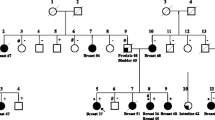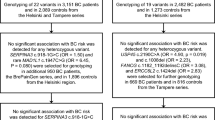Abstract
Purpose
Breast cancer-predisposing mutations PALB2 c.1027C>T (p.Gln343*) and PALB2 c.2167_2168delAT have each been observed multiple times in breast cancer families of Italian ancestry. More recently, the c2167_2168delAT mutation was identified in unrelated breast cancer cases of various ancestries. For each mutation, we investigated whether the origin was multiple mutational events (a “hot-spot”) or a single event (a founder allele).
Methods
We genotyped and reconstructed haplotypes for 36 participants of Italian, Italian-American, Hispanic, and Nigerian ancestries, using seven short tandem repeat (STR) markers that covered 3 Megabases within and flanking PALB2 on chromosome 16.
Results
For PALB2 c.1027C>T, a shared haplotype with a minimum size of 150 kb was shared by all 19 carriers investigated, all of Italian ancestry. This result suggests that this allele arose as a single event in a shared ancestor. For PALB2 c.2167_2168delAT, all 12 carriers from American-Italian and Italian families shared a 1-Mb haplotype, the 3 Hispanic carriers shared a different haplotype of size 2 Mb, and the Nigerian carrier had different alleles at all 7 STR markers. These results suggest that PALB2 c.2167_2168delAT arose multiple times, but that within each population, PALB2 c.2167_2168delAT likely represents a single mutational event.
Conclusion
We identified two PALB2 mutations that are founder alleles in Italian families, one of which is, independently, also a founder mutation in American-Hispanic breast cancers.



Similar content being viewed by others
References
Xia B, Sheng Q, Nakanishi K, Ohashi A, Wu J, Christ N, Liu X, Jasin M, Couch FJ, Livingston DM (2006) Control of BRCA2 cellular and clinical functions by a nuclear partner, PALB2. Mol Cell 22:719–729
Rahman N, Seal S, Thompson D, Kelly P, Renwick A, Elliott A, Reid S, Spanova K, Barfoot R, Chagtai T, Jayatilake H, McGuffog L, Hanks S, Evans DG, Eccles D, Breast Cancer Susceptibility C, Easton DF, Stratton MR (2007) PALB2, which encodes a BRCA2-interacting protein, is a breast cancer susceptibility gene. Nat Genet 39:165–167
Southey MC, Teo ZL, Winship I (2013) PALB2 and breast cancer: ready for clinical translation! Appl Clin Genet 6:43–52
Catucci I, Peterlongo P, Ciceri S, Colombo M, Pasquini G, Barile M, Bonanni B, Verderio P, Pizzamiglio S, Foglia C, Falanga A, Marchetti M, Galastri L, Bianchi T, Corna C, Ravagnani F, Bernard L, Fortuzzi S, Sardella D, Scuvera G, Peissel B, Manoukian S, Tondini C, Radice P (2014) PALB2 sequencing in Italian familial breast cancer cases reveals a high-risk mutation recurrent in the province of Bergamo. Genet Med 16:688–694
Antoniou AC, Casadei S, Heikkinen T, Barrowdale D, Pylkas K, Roberts J, Lee A, Subramanian D, De Leeneer K, Fostira F, Tomiak E, Neuhausen SL, Teo ZL, Khan S, Aittomaki K, Moilanen JS, Turnbull C, Seal S, Mannermaa A, Kallioniemi A, Lindeman GJ, Buys SS, Andrulis IL, Radice P, Tondini C, Manoukian S, Toland AE, Miron P, Weitzel JN, Domchek SM, Poppe B, Claes KB, Yannoukakos D, Concannon P, Bernstein JL, James PA, Easton DF, Goldgar DE, Hopper JL, Rahman N, Peterlongo P, Nevanlinna H, King MC, Couch FJ, Southey MC, Winqvist R, Foulkes WD, Tischkowitz M (2014) Breast-cancer risk in families with mutations in PALB2. N Engl J Med 371:497–506
Kanchi KL, Johnson KJ, Lu C, McLellan MD, Leiserson MD, Wendl MC, Zhang Q, Koboldt DC, Xie M, Kandoth C, McMichael JF, Wyczalkowski MA, Larson DE, Schmidt HK, Miller CA, Fulton RS, Spellman PT, Mardis ER, Druley TE, Graubert TA, Goodfellow PJ, Raphael BJ, Wilson RK, Ding L (2014) Integrated analysis of germline and somatic variants in ovarian cancer. Nat Commun 5:3156
Walsh T, Lee MK, Casadei S, Thornton AM, Stray SM, Pennil C, Nord AS, Mandell JB, Swisher EM, King MC (2010) Detection of inherited mutations for breast and ovarian cancer using genomic capture and massively parallel sequencing. Proc Natl Acad Sci USA 107:12629–12633
Casadei S, Norquist BM, Walsh T, Stray S, Mandell JB, Lee MK, Stamatoyannopoulos JA, King MC (2011) Contribution of inherited mutations in the BRCA2-interacting protein PALB2 to familial breast cancer. Cancer Res 71:2222–2229
Broman KW, Murray JC, Sheffield VC, White RL, Weber JL (1998) Comprehensive human genetic maps: individual and sex-specific variation in recombination. Am J Hum Genet 63:861–869
White JA, McAlpine PJ, Antonarakis S, Cann H, Eppig JT, Frazer K, Frezal J, Lancet D, Nahmias J, Pearson P, Peters J, Scott A, Scott H, Spurr N, Talbot C Jr, Povey S (1997) Guidelines for human gene nomenclature. HUGO Nomenclature Committee. Genomics 45:468–471
Dansonka-Mieszkowska A, Kluska A, Moes J, Dabrowska M, Nowakowska D, Niwinska A, Derlatka P, Cendrowski K, Kupryjanczyk J (2010) A novel germline PALB2 deletion in Polish breast and ovarian cancer patients. BMC Med Genet 11:20
Noskowicz M, Bogdanova N, Bermisheva M, Takhirova Z, Antonenkova N, Khusnutdinova E, Bremer M, Christiansen H, Park-Simon TW, Hillemanns P, Dork T (2014) Prevalence of PALB2 mutation c.509_510delGA in unselected breast cancer patients from Central and Eastern Europe. Fam Cancer 13:137–142
Foulkes WD, Ghadirian P, Akbari MR, Hamel N, Giroux S, Sabbaghian N, Darnel A, Royer R, Poll A, Fafard E, Robidoux A, Martin G, Bismar TA, Tischkowitz M, Rousseau F, Narod SA (2007) Identification of a novel truncating PALB2 mutation and analysis of its contribution to early-onset breast cancer in French-Canadian women. Breast Cancer Res 9:R83
Erkko H, Dowty JG, Nikkila J, Syrjakoski K, Mannermaa A, Pylkas K, Southey MC, Holli K, Kallioniemi A, Jukkola-Vuorinen A, Kataja V, Kosma VM, Xia B, Livingston DM, Winqvist R, Hopper JL (2008) Penetrance analysis of the PALB2 c.1592delT founder mutation. Clin Cancer Res 14:4667–4671
Southey MC, Teo ZL, Dowty JG, Odefrey FA, Park DJ, Tischkowitz M, Sabbaghian N, Apicella C, Byrnes GB, Winship I, Baglietto L, Giles GG, Goldgar DE, Foulkes WD, Hopper JL, kConFab for the Beast Cancer Family R (2010) A PALB2 mutation associated with high risk of breast cancer. Breast Cancer Res 12:R109
Caleca L, Putignano AL, Colombo M, Congregati C, Sarkar M, Magliery TJ, Ripamonti CB, Foglia C, Peissel B, Zaffaroni D, Manoukian S, Tondini C, Barile M, Pensotti V, Bernard L, Papi L, Radice P (2014) Characterization of an Italian founder mutation in the RING-finger domain of BRCA1. PLoS One 9:e86924
Cavalli-Sforza L, Menozzi P, Piazza A (1994) The history and geography of human genes. Princeton University Press, Princeton
Funding
Work in Italy was partially supported by funds from Ministero della Salute, Italy; Ricerca Finalizzata (RF-2010-2316374 to PP and CT); AIRC Associazione Italiana per la Ricerca sul Cancro (IG 12821 to PP and “5xmille” n. 12237 to AF), and from Italian citizens who allocated a 5/1000 share of their tax payment in support of the Fondazione IRCCS Istituto Nazionale Tumori (SM and PR). Work at University of Washington was supported by NIH R01CA175716 (M-CK) and R35CA197458 (M-CK). Work at City of Hope (COH) was supported by R01CA184585 (SLN), a COH Excellence Award (SLN), and the Morris and Horowitz Families Professorship (SLN). Work performed in the Integrative Genomics Core was supported by the National Cancer Institute of the National Institutes of Health under award number P30CA033572. Work at University of Chicago was supported by American Cancer Society CRP-10-119-01 –CCE (OIO) and the Susan G. Komen Foundation (OIO). The City of Hope Clinical Cancer Genetics Community Research Network was supported in part by Award Number RC4A153828 (PI: J. Weitzel) from the National Cancer Institute and the Office of the Director, National Institutes of Health. The content is solely the responsibility of the authors and does not necessarily represent the official views of the National Institutes of Health.
Author information
Authors and Affiliations
Corresponding author
Ethics declarations
Conflict of interest
The authors declare that they have no conflicts of interest.
Ethical approval
All procedures performed in studies involving human participants were in accordance with the ethical standards of the institutional and/or national research committee and with the 1964 Helsinki declaration and its later amendments or comparable ethical standards.
Additional information
Irene Catucci, Silvia Casadei and Yuan Chun Ding—Co-first authorship.
Paolo Peterlongo and Susan L. Neuhausen—Co-last authorship.
Electronic supplementary material
Below is the link to the electronic supplementary material.
Rights and permissions
About this article
Cite this article
Catucci, I., Casadei, S., Ding, Y.C. et al. Haplotype analyses of the c.1027C>T and c.2167_2168delAT recurrent truncating mutations in the breast cancer-predisposing gene PALB2. Breast Cancer Res Treat 160, 121–129 (2016). https://doi.org/10.1007/s10549-016-3981-y
Received:
Accepted:
Published:
Issue Date:
DOI: https://doi.org/10.1007/s10549-016-3981-y




